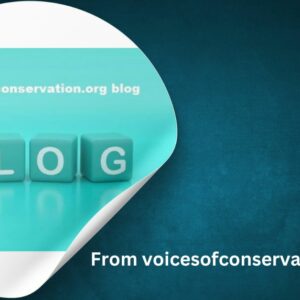Environmental conservation is more critical than ever. As climate change, habitat loss, and pollution threaten our planet, every voice counts in the fight to protect our natural world.
From voicesofconservation.org blog, we explore the powerful impact of individual and collective actions in preserving our environment.
This article delves into the core principles and innovative approaches that make this platform a vital resource for conservationists.
The Role of Individual Voices in Environmental Conservation
From voicesofconservation.org blog, it’s clear that individual voices can drive significant change.
Each person’s commitment to sustainable practices contributes to the broader goal of environmental preservation.
Simple actions, like reducing waste, conserving water, and supporting eco-friendly products, collectively lead to substantial positive impacts.
Read: Exploring Fun88ML.com – A Comprehensive Guide
Key Actions Individuals Can Take:
Reduce, Reuse, Recycle: The Three Pillars of Waste Management
Implementing the 3Rs—Reduce, Reuse, Recycle—in daily life is crucial for minimizing waste and promoting resource conservation.
Reducing involves making conscious decisions to use fewer resources, such as buying products with minimal packaging or choosing durable goods over disposable ones.
Reusing extends the life of items by finding new purposes for them, like repurposing glass jars for storage or donating clothes instead of discarding them.
Recycling involves processing materials like paper, plastic, and metal so they can be used to make new products, thus reducing the need for raw materials and decreasing landfill waste.
Adopting these practices helps conserve natural resources, reduce pollution, and mitigate the negative impacts of waste on the environment.
Energy Conservation: Efficient Use of Resources
Conserving energy is another vital component of environmental protection. By using energy-efficient appliances, such as LED light bulbs, smart thermostats, and energy-saving refrigerators,
We can significantly reduce our energy consumption. Additionally, simple actions like turning off lights when not in use, unplugging electronics, and setting thermostats to eco-friendly temperatures can lower energy usage.
These measures decrease our carbon footprints, which is the total amount of greenhouse gasses we are responsible for emitting.
Reducing energy consumption not only helps mitigate climate change but also lowers utility bills, making it a win-win for both the environment and our wallets.
Read: Discover Orangîa: The Enchanting Land and the Extraordinary Fruit
Supporting Green Initiatives: Amplifying Collective Impact
Supporting green initiatives involves actively participating in or donating to environmental organizations.
These organizations work tirelessly to address various environmental issues, from protecting endangered species to advocating for clean energy policies.
By volunteering with local conservation projects, participating in tree planting events, or contributing financially to reputable environmental charities, individuals can amplify their impact on conservation efforts.
Supporting these initiatives also includes advocating for sustainable practices within communities, such as promoting recycling programs, supporting local farmers markets, and encouraging businesses to adopt eco-friendly practices.
Collective efforts through these initiatives drive substantial progress in preserving our planet for future generations.
Collaborative Efforts: Communities and Organizations
The blog emphasizes that collaboration among communities and organizations amplifies conservation impacts.
Grassroots movements and local conservation projects harness the collective power of communities, driving significant environmental improvements.
Successful Collaborative Initiatives:
- Community Clean-ups: Organized efforts to clean local parks, rivers, and beaches foster a sense of responsibility and community spirit.
- Educational Programs: Schools and local groups educating the public about sustainable practices create a more environmentally aware society.
- Partnerships with Businesses: Collaborations between environmental organizations and corporations lead to innovative, sustainable business practices.
Read: Silver Price FintechZoom – Real-Time Data and Market Insights
Innovative Approaches in Conservation
From voicesofconservation.org blog, we learn about cutting-edge techniques and technologies transforming conservation efforts. Innovation plays a crucial role in addressing complex environmental challenges.
Noteworthy Innovations:
- Drones in Wildlife Monitoring: Drones provide invaluable data on wildlife populations and habitat health, aiding in more effective conservation strategies.
- Biodegradable Materials: The development of biodegradable alternatives to plastics reduces pollution and its harmful impacts on wildlife.
- Renewable Energy Sources: Advancements in solar, wind, and hydroelectric power contribute to reducing reliance on fossil fuels.
The Importance of Policy and Advocacy
Advocacy and policy changes are crucial in driving large-scale environmental conservation.
From voicesofconservation.org blog highlights the importance of influencing policies that promote sustainability and protect natural resources.
Effective Advocacy Strategies:
- Lobbying for Environmental Legislation:
Engaging with lawmakers to pass regulations that limit pollution and protect endangered species.
- Public Awareness Campaigns:
Educating the public on environmental issues to build support for policy changes.
- Collaborating with Government Agencies:
Working alongside government bodies to implement and enforce environmental regulations.
Read: GDP – Deleted Scene – E355 – Unveiling the
Global Perspectives on Conservation
Environmental issues transcend borders, requiring a global approach. From voicesofconservation.org blog, we see examples of international cooperation in tackling these challenges.
Global Conservation Efforts:
- International Treaties: Agreements like the Paris Climate Accord unite countries in the fight against climate change.
- Cross-border Conservation Projects: Initiatives that span multiple countries, such as the preservation of the Amazon Rainforest, demonstrate the power of global collaboration.
- Sharing Knowledge and Resources: Countries and organizations sharing expertise and technology enhance global conservation capabilities.
Success Stories:
The blog features numerous success stories that inspire and inform conservation efforts. These case studies illustrate the tangible outcomes of dedicated conservation work.
Inspiring Case Studies:
- Restoration of Coral Reefs: Collaborative efforts have led to significant recovery of damaged coral reefs, preserving marine biodiversity.
- Reforestation Projects: Large-scale tree planting initiatives have restored forests, providing critical habitats and combating climate change.
- Wildlife Conservation Programs: Success in breeding and reintroducing endangered species into the wild highlights the impact of focused conservation efforts.
Challenges in Environmental Conservation
From voicesofconservation.org blog, we also learn about the challenges facing conservationists.
Understanding these obstacles is essential for developing effective strategies to overcome them.
Major Challenges:
- Climate Change: Rising temperatures and changing weather patterns disrupt ecosystems and biodiversity.
- Pollution: Plastic waste, chemical pollutants, and air pollution have devastating effects on wildlife and habitats.
- Habitat Destruction: Deforestation, urbanization, and agriculture lead to the loss of crucial habitats for many species.
The Future of Conservation: Trends and Predictions
The blog provides insights into future trends and predictions in environmental conservation. Staying informed about these trends helps conservationists adapt and innovate.
Emerging Trends:
- Increased Use of Technology: Artificial intelligence and machine learning in conservation efforts enhance data analysis and decision-making.
- Sustainable Urban Development: Designing cities with sustainability in mind reduces environmental impact and improves quality of life.
- Corporate Responsibility: More businesses adopting sustainable practices and prioritizing environmental responsibility.
How to Get Involved?
From voicesofconservation.org blog encourages readers to get involved in conservation efforts. Everyone has a part to play in safeguarding our planet.
Ways to Get Involved:
- Volunteer: Join local conservation projects or participate in community clean-up events.
- Advocate: Raise awareness about environmental issues and support policies that promote sustainability.
- Educate: Share knowledge about conservation with friends, family, and social networks.
Read: Exploring Fun88ML.com – A Comprehensive Guide
FAQS
1. Why does every voice matter in conservation?
Every voice contributes to the collective effort needed to protect our planet, demonstrating that individual and community actions can lead to significant environmental improvements.
2. Why is advocacy important in environmental conservation?
Advocacy influences policies that promote sustainability and protect natural resources, leading to large-scale environmental improvements.
3. What are some innovative technologies in conservation?
Drones for wildlife monitoring, biodegradable materials, and renewable energy sources are some of the innovative technologies transforming conservation efforts.
4. What are some global conservation efforts?
International treaties like the Paris Climate Accord, cross-border conservation projects, and the sharing of knowledge and resources are key global.
Read: VC7774 – Your Complete Guide to Samsung VC7774 Vacuum Bags
Conclusion:
From voicesofconservation.org blog, we learn the profound impact each individual and community can have on environmental conservation.
By adopting practices like Reduce, Reuse, Recycle, and conserving energy, we contribute significantly to preserving our planet. Supporting green initiatives and advocating for sustainable policies amplify our collective efforts. Innovation and global cooperation further enhance conservation strategies.
Every voice matters in the fight against environmental degradation. United, we can build a sustainable future for generations ahead.




